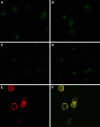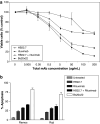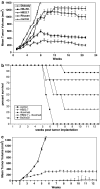The Bs20x22 anti-CD20-CD22 bispecific antibody has more lymphomacidal activity than do the parent antibodies alone
- PMID: 21347809
- PMCID: PMC3098984
- DOI: 10.1007/s00262-011-0978-6
The Bs20x22 anti-CD20-CD22 bispecific antibody has more lymphomacidal activity than do the parent antibodies alone
Abstract
Previous studies have shown that bispecific antibodies that target both CD20 and CD22 have in vivo lymphomacidal properties. We developed a CD20-CD22 bispecific antibody (Bs20x22) from anti-CD20 and the anti-CD22 monoclonal antibodies (mAb), rituximab and HB22.7, respectively. Bs20x22 was constructed using standard methods and was shown to specifically bind CD20 and CD22. In vitro cytotoxicity assays showed that Bs20x22 was three times more effective than either parent mAb alone and twice as effective as a combination of both parent mAb used at equimolar concentrations. Bs20x22 was also nearly four times more effective at inducing apoptosis than either mAb alone. Examination of the MAPK and SAPK signaling cascades revealed that Bs20x22 induced significantly more p38 phosphorylation than either mAb alone. In an in vivo human NHL xenograft model, treatment with Bs20x22 resulted in significantly greater tumor shrinkage and improved overall survival when compared to either mAb alone or treatment with a combination of HB22.7 and rituximab. The effect of the initial tumor volume was assessed by comparing the efficacy of Bs20x22 administered before xenografts grew versus treatment of established tumors; significantly, greater efficacy was found when treatment was initiated before tumors could become established.
Figures




Similar articles
-
Bispecific anti-CD20/22 antibodies inhibit B-cell lymphoma proliferation by a unique mechanism of action.Blood. 2008 Feb 15;111(4):2211-9. doi: 10.1182/blood-2007-08-110072. Epub 2007 Nov 19. Blood. 2008. PMID: 18025153 Free PMC article.
-
Anti-CD22 ligand-blocking antibody HB22.7 has independent lymphomacidal properties and augments the efficacy of 90Y-DOTA-peptide-Lym-1 in lymphoma xenografts.Blood. 2003 May 1;101(9):3641-7. doi: 10.1182/blood-2002-08-2629. Epub 2003 Jan 2. Blood. 2003. PMID: 12511412
-
The HB22.7 Anti-CD22 monoclonal antibody enhances bortezomib-mediated lymphomacidal activity in a sequence dependent manner.J Hematol Oncol. 2011 Dec 1;4:49. doi: 10.1186/1756-8722-4-49. J Hematol Oncol. 2011. PMID: 22128838 Free PMC article.
-
[Immunotherapy of non-Hodgkin's lymphomas (NHL) by anti-CD22 antibody--review].Zhongguo Shi Yan Xue Ye Xue Za Zhi. 2006 Dec;14(6):1258-61. Zhongguo Shi Yan Xue Ye Xue Za Zhi. 2006. PMID: 17204206 Review. Chinese.
-
What signals are generated by anti-CD20 antibody therapy?Curr Hematol Malig Rep. 2006 Dec;1(4):205-13. doi: 10.1007/s11899-006-0001-z. Curr Hematol Malig Rep. 2006. PMID: 20425315 Review.
Cited by
-
A tale of two specificities: bispecific antibodies for therapeutic and diagnostic applications.Trends Biotechnol. 2013 Nov;31(11):621-32. doi: 10.1016/j.tibtech.2013.08.007. Epub 2013 Oct 2. Trends Biotechnol. 2013. PMID: 24094861 Free PMC article. Review.
-
Therapeutic Antibodies: What Have We Learnt from Targeting CD20 and Where Are We Going?Front Immunol. 2017 Oct 4;8:1245. doi: 10.3389/fimmu.2017.01245. eCollection 2017. Front Immunol. 2017. PMID: 29046676 Free PMC article. Review.
-
Mechanisms of Resistance to Monoclonal Antibodies (mAbs) in Lymphoid Malignancies.Curr Hematol Malig Rep. 2019 Oct;14(5):426-438. doi: 10.1007/s11899-019-00542-8. Curr Hematol Malig Rep. 2019. PMID: 31559580 Review.
-
Molecular Aspects of Resistance to Immunotherapies-Advances in Understanding and Management of Diffuse Large B-Cell Lymphoma.Int J Mol Sci. 2022 Jan 28;23(3):1501. doi: 10.3390/ijms23031501. Int J Mol Sci. 2022. PMID: 35163421 Free PMC article. Review.
-
CD20-targeting in B-cell malignancies: novel prospects for antibodies and combination therapies.Invest New Drugs. 2016 Aug;34(4):497-512. doi: 10.1007/s10637-016-0349-4. Epub 2016 Apr 13. Invest New Drugs. 2016. PMID: 27075017 Review.
References
-
- Ries L, Melbert D, Krapcho M, Stinchcomb D, Howlader N, Horner M, Mariotto A, Miller B, Feuer E, Altekruse S, Lewis D, Clegg L, Eisner M, Reichman M, Edwards BE. SEER cancer statistics review, 1975–2005. Bethesda, MD: National Cancer Institute; 2008.
-
- Lindley C. The lymphomas: Hodgkin’s disease and non-Hodgkin’s lymphomas. Am Pharm NS. 1991;31:46–51. - PubMed
-
- Schumer ST, Joyce RM (2003) Radioimmunotherapy for Non-Hodgkin’s Lymphoma. Progress Oncol 46–72
Publication types
MeSH terms
Substances
LinkOut - more resources
Full Text Sources
Other Literature Sources

